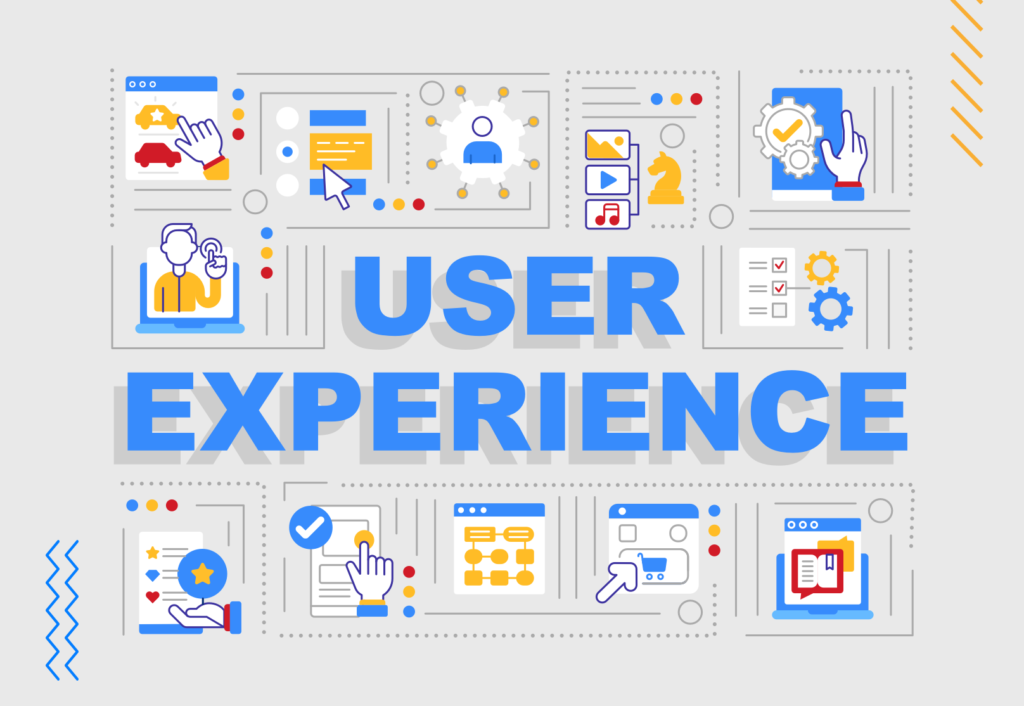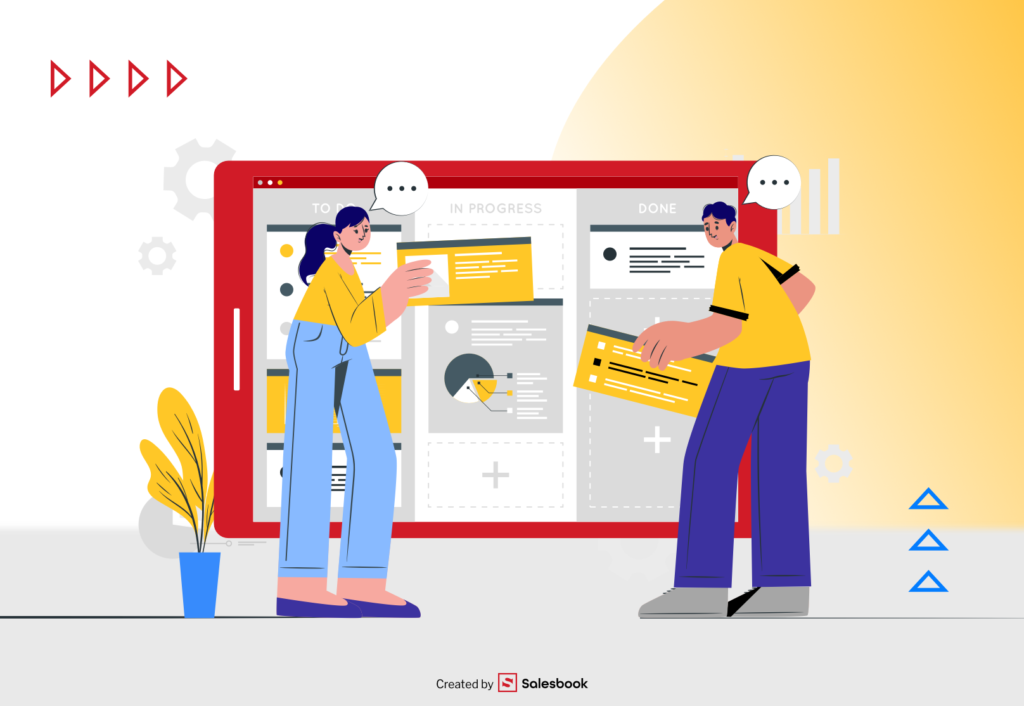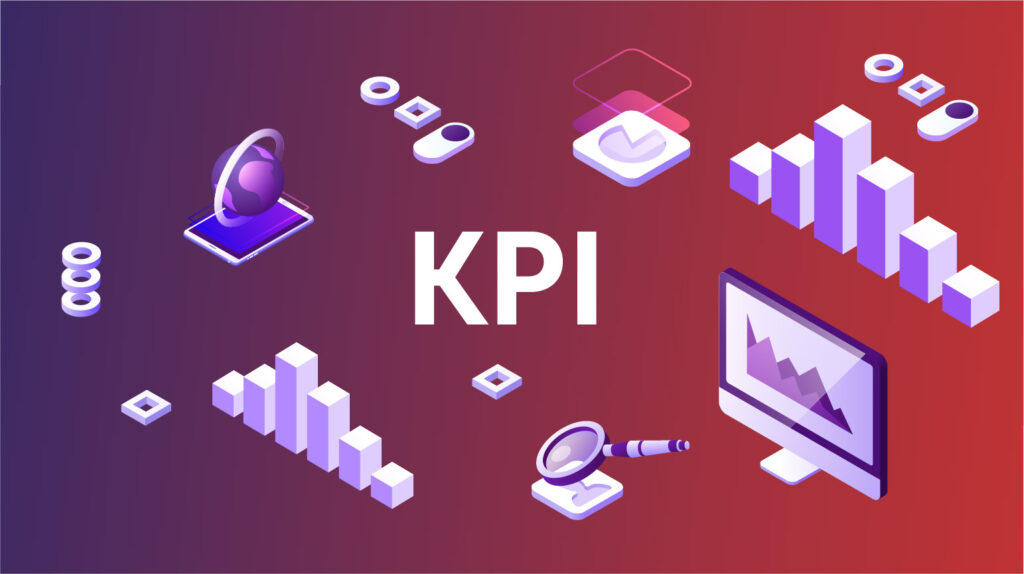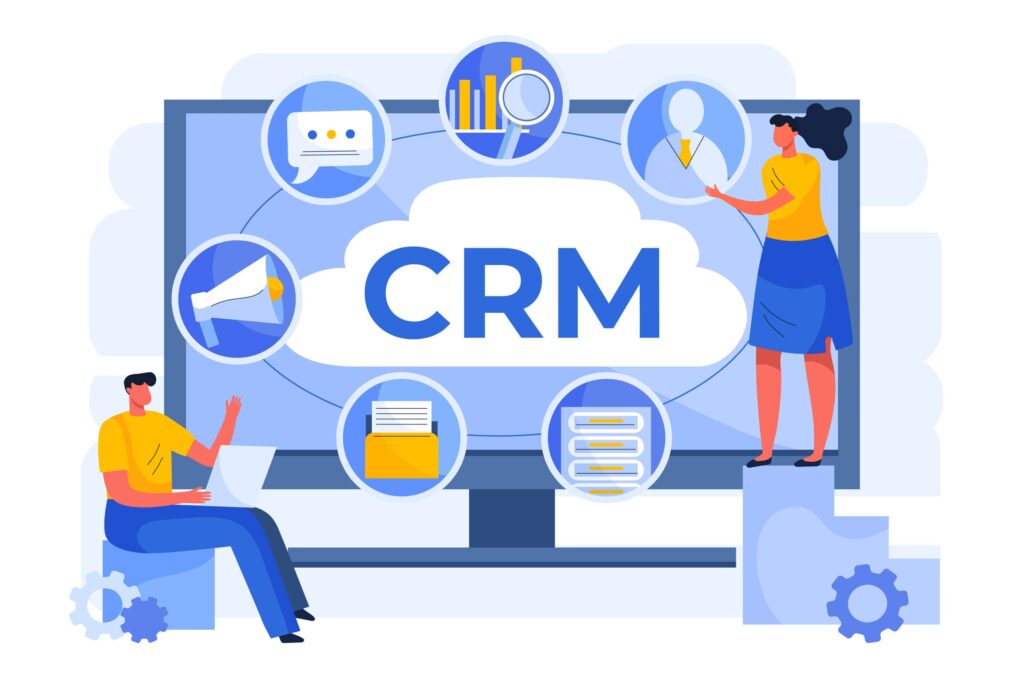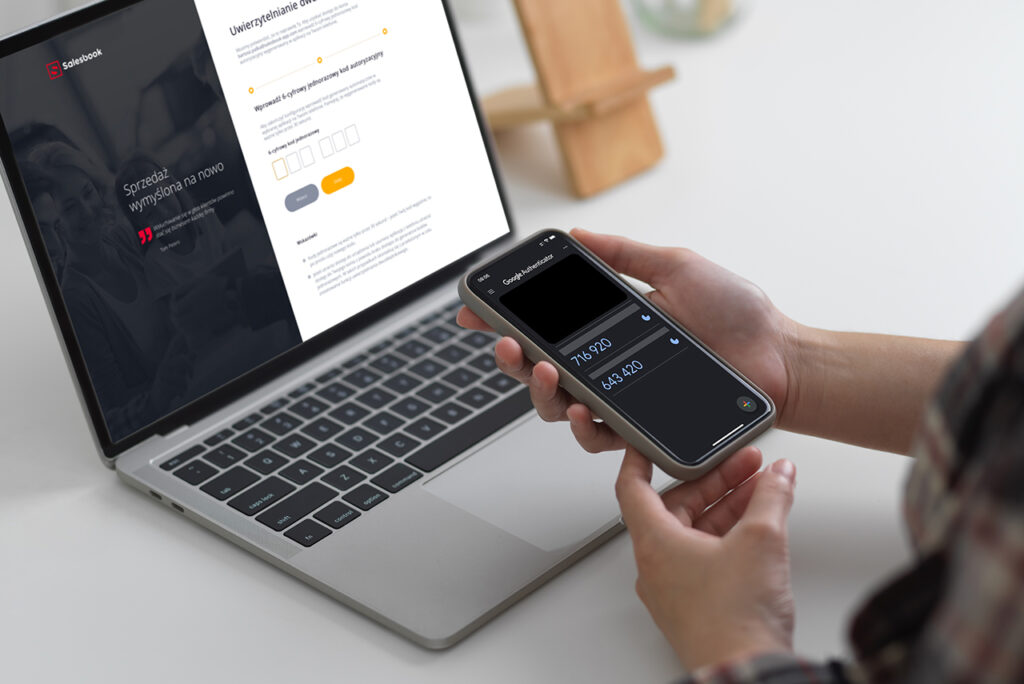Employee onboarding process with Salesbook. How to build it?

Only 12% of employees are satisfied with their onboarding process – shows the latest research made by the Gallup Institute. How to prepare a professional onboarding program and use technology to do it? Read about how to automate employee onboarding with Salesbook.
What is employee onboarding process?
In simple words, onboarding is the process of familiarizing a new hire with an organization. Usually, it takes several days or weeks.
The term onboarding refers to aviation, where it means the procedure of boarding travelers. However, employee onboarding is also used by HR (Human Resources) as the name of the process of welcoming a new person “on the board” of the company, where a new journey begins.
The onboarding process is essential not only for HR and new employees but also for different departments in a company. It engages many people, including a hiring manager, buddy, direct managers, and team members.
An onboarding buddy is a person whose role is to be the strongest support for a new hire and help a new person get acclimated within an organization.
New employees are not as satisfied as they may seem
There are many reasons why the employee onboarding process should be thoroughly planned and well-thought-out. Information that an HR manager conveys during a recruitment process must reflect an actual situation in your company.
According to different sources, 33 to 50% of new employees are dissatisfied with their new jobs and change them after six months. One of the reasons for that is disappointment with the onboarding program.

The latest Gallup Institute research shows that only 12% of employees are satisfied with their onboarding process.
At this point, we should ask the question about the beginning of the employee onboarding process. In different sources about onboarding processes, you can find information that onboarding starts before the first day of a new hire and ends when a new employee is utterly independent and supports their team.
The four stages of the effective onboarding process
Considering the complexity of onboarding, Talya N. Bauer, a researcher and professor at Portland State University created the 4c’ model of onboarding. She explored this topic in her publication “Onboarding New Employees: Maximizing Success”. According to her, there are four stages of the effective onboarding process.
The 4c’s model and its stages:
- Compliance – it is the lowest level of onboarding, it starts before new hires start their first day at work, it consists of administrative stuff such as formal issues, basic information about an organization and its procedures, law regulations, necessary training program, etc.It is the time for the new hire paperwork. A new employee should deliver all the documents to HR professionals: diplomas, certificates, employee information forms, and results of occupational medicine examinations. At this point, the company should give an employee access to the necessary programs and tools needed during everyday work.An automated onboarding process allows companies to speed up some elements such as signing documents or administrative tasks.
- Clarification – it is an explanation of the responsibilities and a conversation with a new hire about all the tasks at their position. It is the moment for an HR manager to make sure that a new employee understands their role.A new hire should be familiarized with all the details, on the other hand, every team member should also know about the duties of their new colleague.
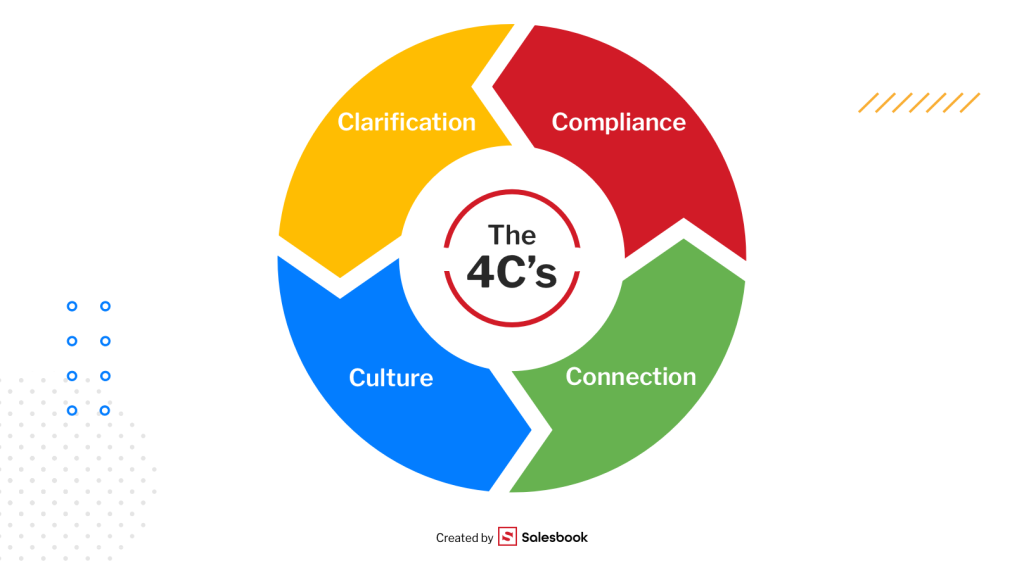
- Culture – at this stage, new hires should get to know the company culture, company policies, and social norms present in an organization. New employees have to be aware of the mission, vision, and values important to the company.Some companies create a special manual for new hires (an employee handbook) that contains the most important information or introduces “company ambassadors”. These are the employees that believe in company values and are eager to share their knowledge with new hires.
- Connection – this is the moment of relationship building when new hires meet their new co-workers and a team. It is essential to create opportunities for new and existing employees to develop long-term relationships. It will affect not only the positive onboarding experience but also the future atmosphere among team members.Sometimes this stage is neglected by HR managers which is a big mistake. They think that it is good to let things run their own way.
Some sources mention also the stage of pre-boarding as the stage before Compliance and signing a contract with a new hire. It relies on preparation of the workplace, documents by the HR department, (for example, occupational medicine examinations), and giving necessary access to programs or tools.
Employee onboarding process and strategies of HR departments
The onboarding process is described in many sources in terms of the 4c’s model and different strategies applied by HR teams.
The passive onboarding process is when the activities of an HR team are restricted only to basic elements. A new hire is familiarized with documents, procedures, and company policies.
On the other hand, the proactive onboarding process relies not only on giving a new employee the necessary documents but also on defining company culture, meeting co-workers and other employees. We can say that this onboarding strategy takes all elements of the 4C’s model into account.
What is the duration of the employee onboarding process?
Talya N. Bauer, the author of the 4C’s model, in her publication “Onboarding New Employees: Maximizing Success” claims that a new hire needs even 90 days to get to know all their duties and be effective.
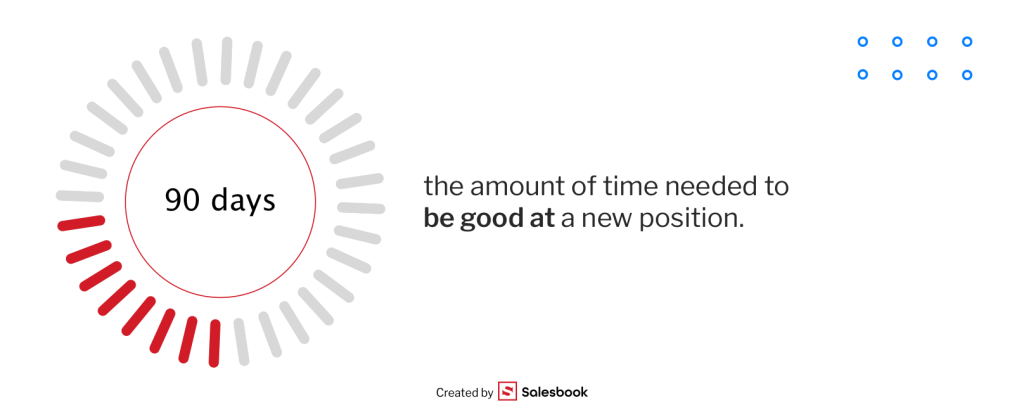
Unfortunately, sometimes onboarding process is far from such standards. For example, research done in Poland (Gamfi, 2021) shows that in 56% of companies, the employee onboarding process usually lasts a week (in the case of 21% of these organizations, new employees get acquainted with the company policies during one day). In 36% of companies, onboarding lasts from 2 to 6 days.
How about the worldwide statistics? According to the data given by BambooHR in 2023, only 37% of businesses claim that their company’s onboarding program last for more than 30 days.
It is surprising in the light of information from the Gallup Institute – a new hire is the most effective after 12 months. Therefore, companies should make the most of that time to prepare a new employee for all tasks and duties. Focusing only on filling in documents and learning about procedures can turn against HR managers.
It is essential for one more reason, many employers do not think about the negative onboarding experience and its consequences. Starting a new job is very stressful and if the employee onboarding process is chaotic, it can be even worse.
Why is the professional employee onboarding process so important?
Being a new hire is usually associated with stress. New employees are both stressed out and excited to meet other co-workers. In the 60s., Thomas Holmes and Richard Rahe, two psychiatrists examined the stress phenomenon and created a list of the 44 most stressful events in life. It turns out that changing a job ranks in the top twenty.
Since a job change is stressful, HR managers should think over the employee onboarding process and modify it in the entire company. Every wrong decision made by an employer and every negligence can negatively affect the employee retention rate.
Reasons why the onboarding experience and the entire process are significant:
- The employee onboarding process is expensive – if the formal onboarding program in your company is well-prepared and it takes positive employee experience into account, you do not need to worry. It takes time to train a new hire, however, it also consumes your money.According to BambooHR (data from 2023), employers have to spend around $7,500–$28,000 to hire an employee. Costs include job board fees, background checks, and the new hire’s salary.Moreover, the costs can be even higher if you fail and your employee decides to leave. The Society for Human Resource Management (SHRM) reports that a bad onboarding process affects employee turnover and increases it by 50% in the first several months of employment.
- You support employer branding solutions – still, not many employers realize that a well-planned onboarding program harmonizes with the good onboarding experience of new hires. The coexistence of these two aspects brings long-term advantages that are more than just financial benefits for an employer.A satisfied employee will tell their friends about your company and future possibilities. According to Digitate and its data published several years ago, 1 in 5 candidates do not recommend a new company because of ill-prepared onboarding.
- You increase the chances that new hires will stay longer in your company – as the Brandon Hall Group research reports, a successful onboarding program increases employee retention by 82%. Moreover, 91% of new hires who assessed their onboarding as satisfactory and got to know the organizational culture of the company, feel more connected to the workplace.
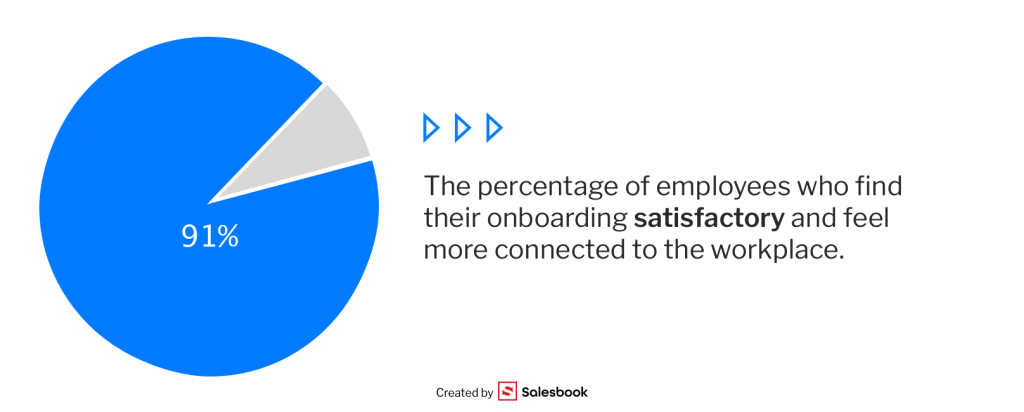
- You increase the effectiveness of a new hire and the entire team – obviously, new hires need more time to get to know new responsibilities. The Brandon Hall Group report gives information that good employee onboarding affects new hires’ effectiveness by up to 70%.
- You affect employee engagement and identification with your business values – BambooHR research shows that 89% of new hires who positively assess the onboarding process indicate a greater commitment to their duties.
- You can collect feedback after onboarding and make improvements if they are necessary – the Pulsce Check research is frequently used by HR managers to obtain feedback after the onboarding process. Thanks to it, you know if onboarding has its essential elements and if the employee onboarding workflow does not come across obstacles.
- Employee onboarding automation allows you to save time, co-workers can devote less time to new hires – the new employee onboarding process engages the HR department, managers, and co-workers. Automated onboarding can take on some of their responsibilities.
Employee onboarding automation and its advantages
After March 2020, the automation and digitalization of processes have accelerated, which is reflected in trends concerning the organization of work.
The IDC report (“Digital Work Transformation 2021”) shows that 84% of companies around the world plan to increase the digitization of work organization processes. Furthermore, HR departments are interested in automated onboarding processes and their advantages.
Automated employee onboarding allows them to reduce the paperwork and time needed to deal with formal issues.
Why should you choose the automated onboarding process?
- You engage less a manager and team members so they can focus on different important tasks.
- Your HR team reduces formal issues to a minimum. Thanks to automation, they can send automated e-mails, track tasks, schedule reminders, or generate contracts. They do not have to do repetitive tasks.
- You have employee data in one place and an automated onboarding checklist. You avoid unnecessary chaos and know the current stage of onboarding of a new hire.
- Onboarding employees is a repetitive process. If you know best practices and set an effective process, it can be implemented in the whole organization for a longer time. You can also modify it and create personalized onboarding programs for different departments.
- If a flexible onboarding platform that you use, you can tailor elements of onboarding to the needs of your department.
Automated employee onboarding with Salesbook. How to build it?
Salesbook is both a modern application for an iPad and an administration panel (onboarding software) that allows you to plan professional onboarding.
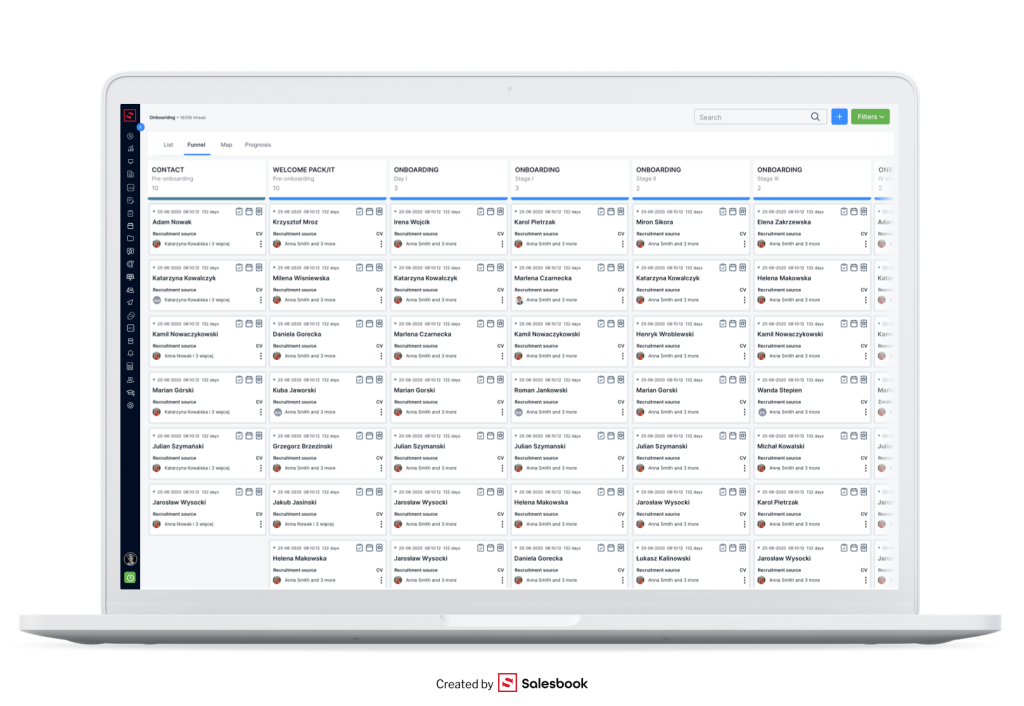
You can start with designing proper communication for new hires. Upload the right documents such as employment contract, confidentiality agreement, form for occupational medicine examinations, or information about benefits.
Thanks to onboarding software, you can send repetitive messages to many new hires at the same time. You can also set a reminder in a system when pre-boarding starts. Just a few clicks are enough to begin the whole process.
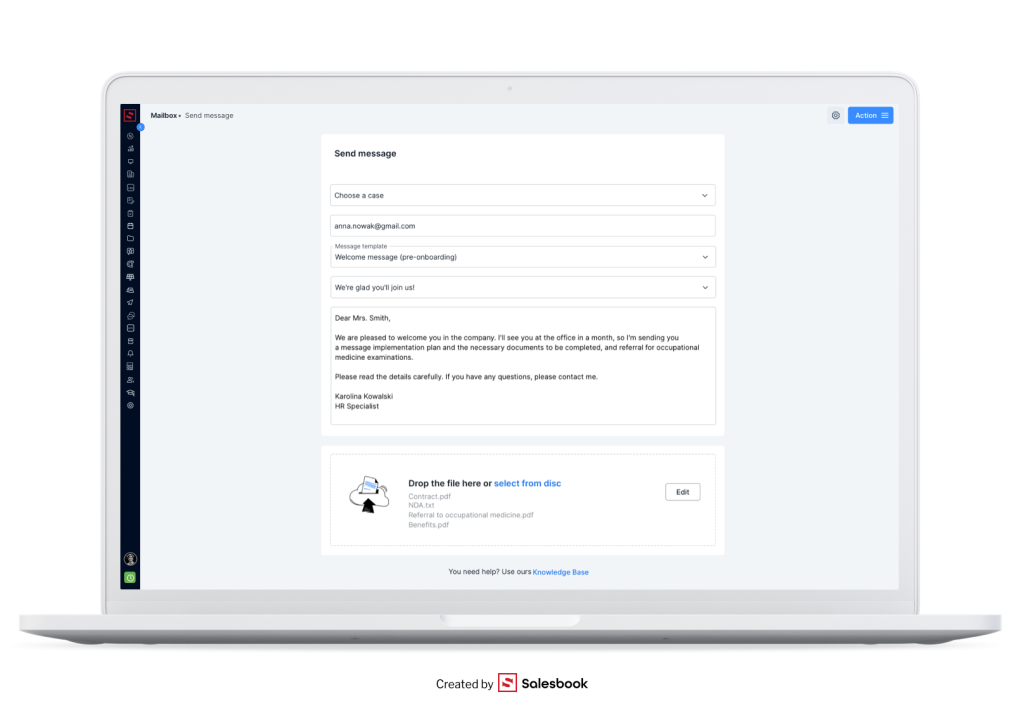
Employee onboarding automation makes it easier for you to send a reminder to managers and a buddy about a new employee. You can mark the names that you choose in a system and send them automated e-mails.
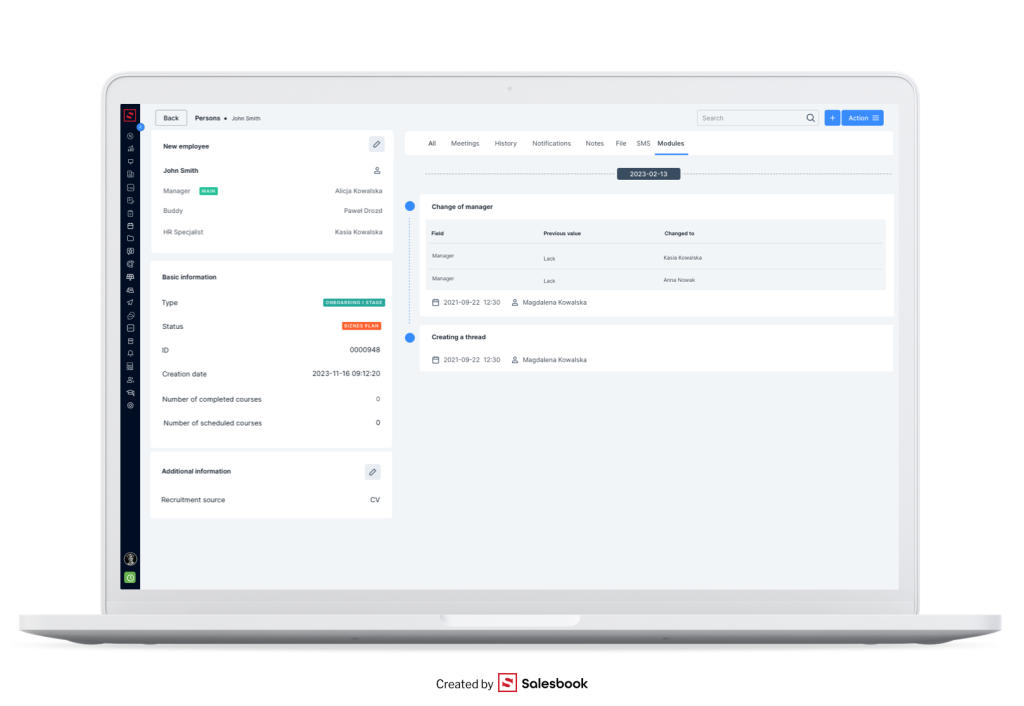
The next step is to order a welcome pack and inform the IT department that a new employee joins the company.
Using an administration panel in Salesbook, you can change an onboarding status if all elements needed in onboarding are complete.
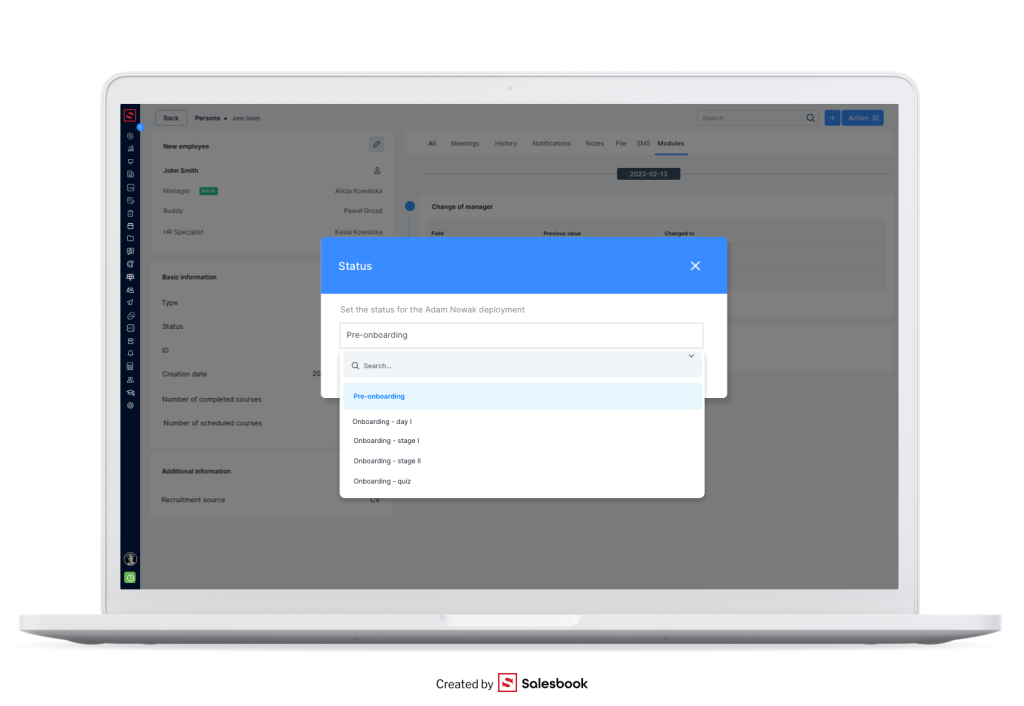
Plan the first day, using employee onboarding automation
Let us assume that an employee has access to necessary tools and a welcome pack on a desk. The first day is almost planned. Thanks to automation, you can be sure if existing employees know about their new colleague, remember about arranged meetings, or have important information.
How can you use Salesbook?
- You send an automated e-mail with a map and guides on how to get to the office. The message can contain an onboarding checklist and a plan for the whole week. You will know if an employee accepts it and gets an e-mail.
- You send automated e-mails to managers and buddies to be sure if they remember their new roles.
- You can plan in detail the whole automated onboarding process and create a personalized program. You can arrange meetings, add co-workers to them, and send reminders.
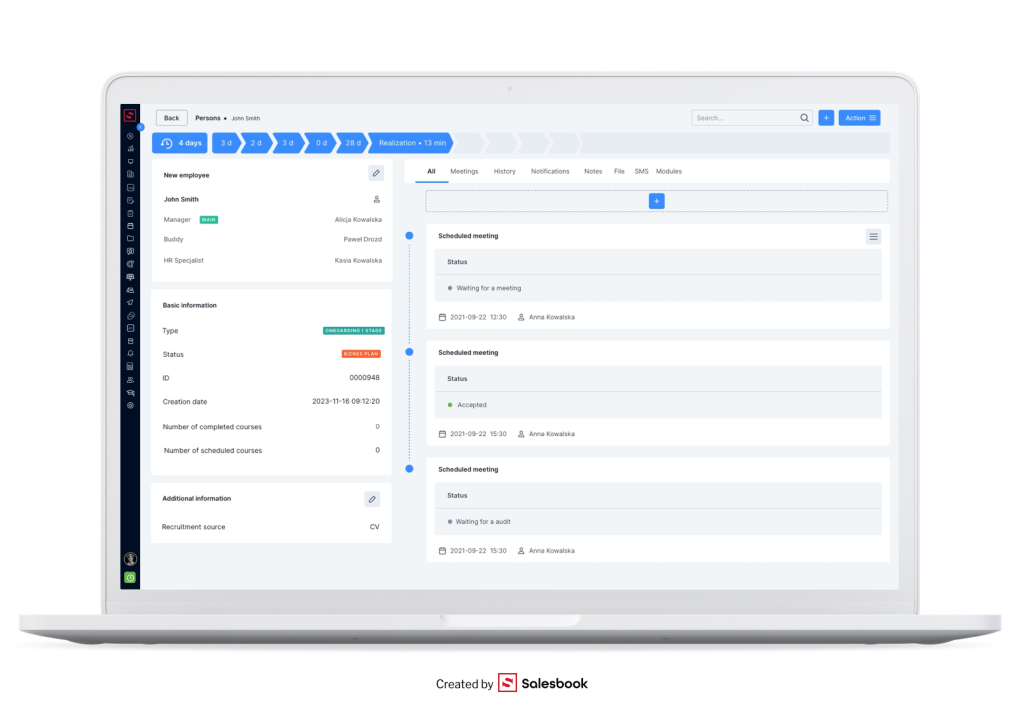
- You send automated e-mails to employees and add personalized information about new hires.
- You plan the next step that relies on providing an employee with the company materials (mission, vision, values). Thanks to Salesbook, a new hire can just use an app to learn more about business.
Automated onboarding – present your company
During the first week, you should familiarize an employee with procedures and information about important courses.
It is also a good time for new hires to learn more about the mission, vision, and values of your company. Some CEOs choose to record a professional video and share it with employees.
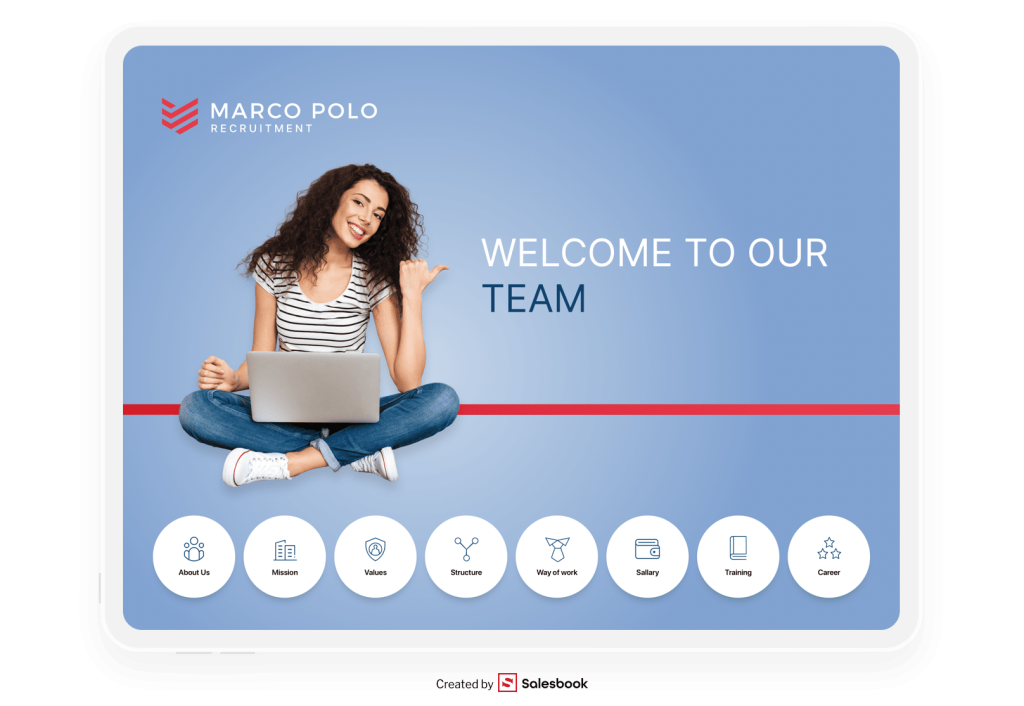
Thanks to Salesbook, you can make your presentation about the company as attractive as possible by uploading videos to the application, adding photos, graphics, visualizations, and personalized text.
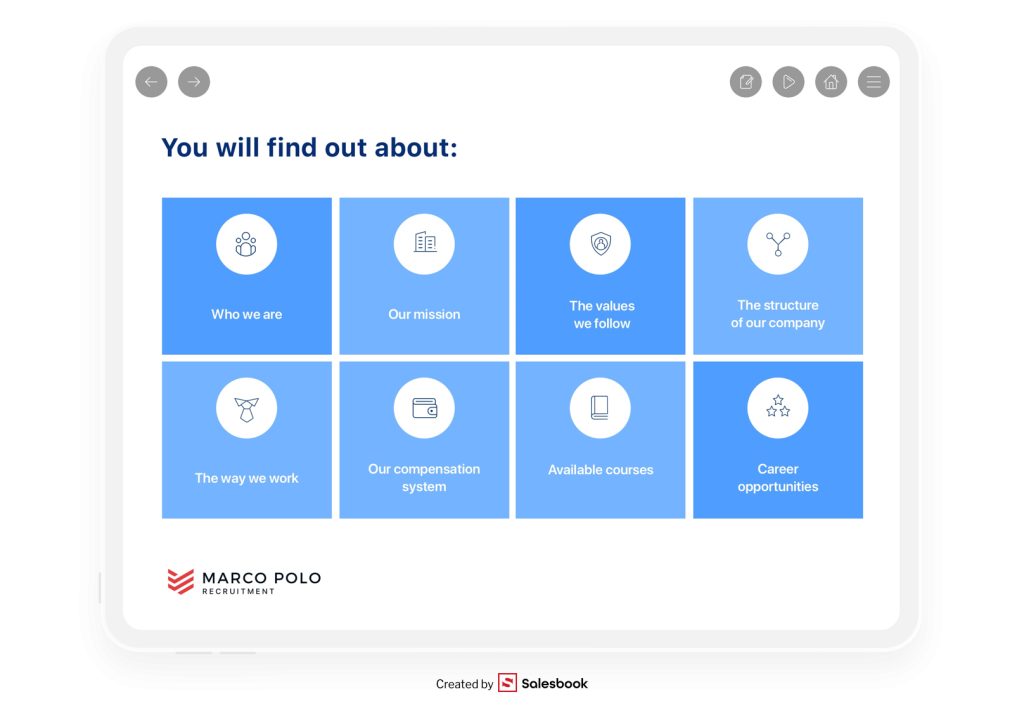
Every time a new hire will read all necessary information in a given section, the HR specialist will be notified.
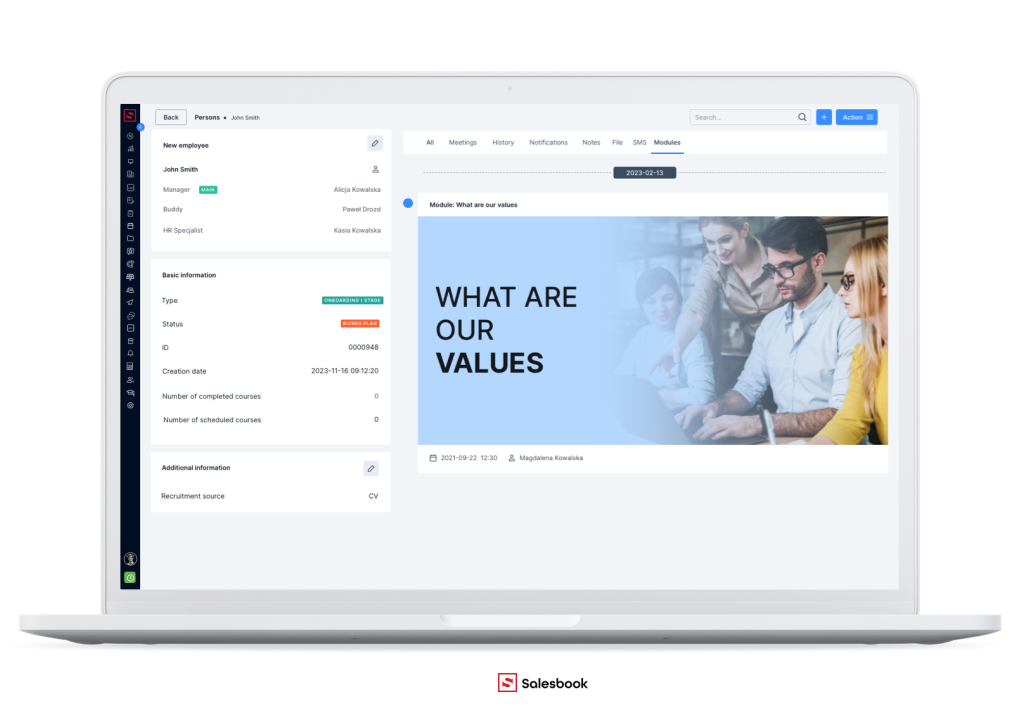
After the part concerning the mission and vision, the new employee should become familiar with the safety rules and anti-discrimination policy.
Obviously, every employee can be overwhelmed with a lot of necessary information. If you want to, you can prepare a FAQ tab.
A new position and new duties
Before a new person joins the team members, they should know more about their responsibilities and the team’s projects. You can add various personalized materials to Salesbook and improve onboarding.
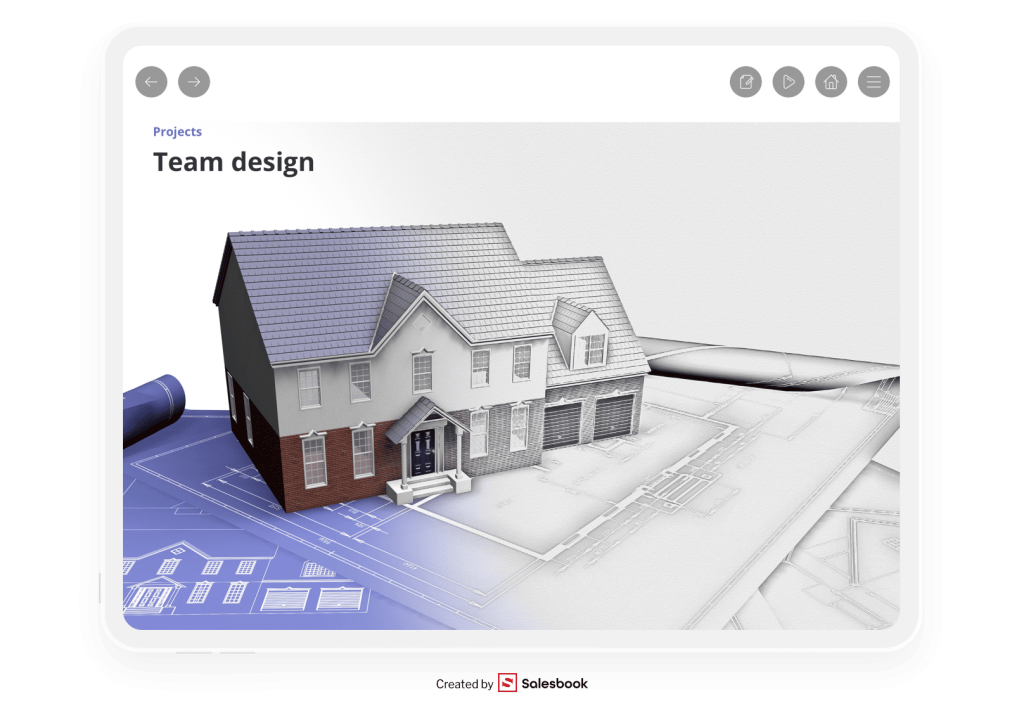
Automated survey
If the last stage of onboarding is about to end, you can plan and send a survey to a new hire. You can ask about impressions and opinions that could help you improve the process.
What can you ask in the survey? Use the following questions:
- Have you received a welcome pack?
- Have you received information about your first day of work?
- Was everything in the implementation materials clear to you?
- Have you received sufficient information from the person assigned to you to help?
- What was missing during the first week of work?
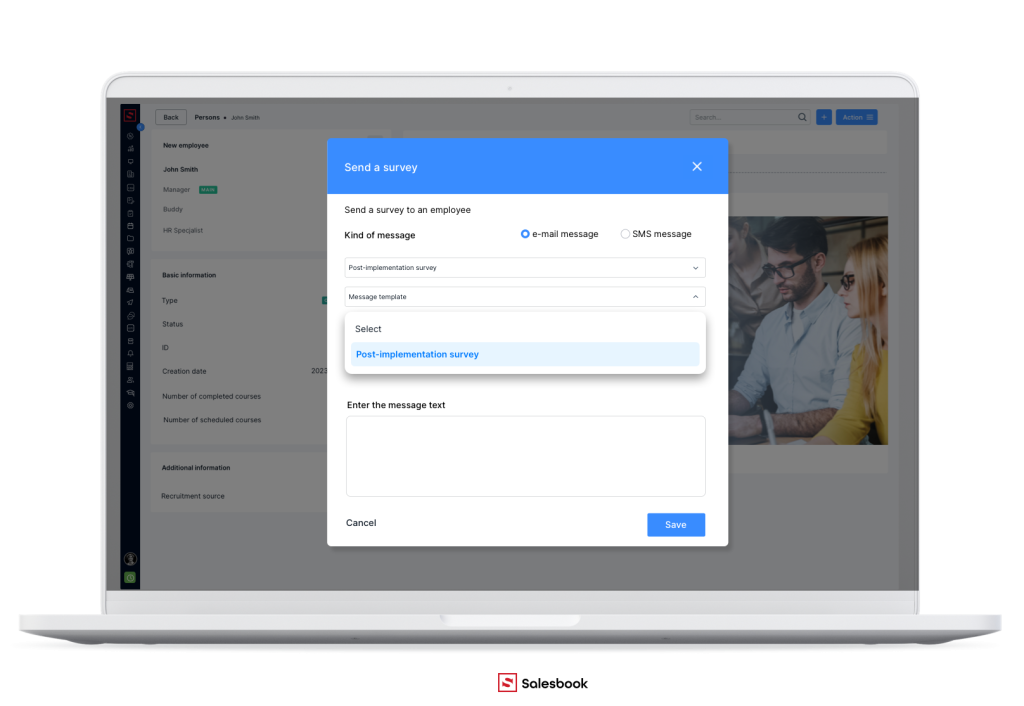
Use Salesbook to personalize onboarding
Salesbook is a flexible tool for employee onboarding automation. If you are interested in using it, try our free demo.
Table of Contents


